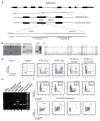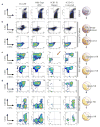Lymphoid regeneration from gene-corrected SCID-X1 subject-derived iPSCs
- PMID: 25772073
- PMCID: PMC4545662
- DOI: 10.1016/j.stem.2015.02.005
Lymphoid regeneration from gene-corrected SCID-X1 subject-derived iPSCs
Abstract
X-linked Severe Combined Immunodeficiency (SCID-X1) is a genetic disease that leaves newborns at high risk of serious infection and a predicted life span of less than 1 year in the absence of a matched bone marrow donor. The disease pathogenesis is due to mutations in the gene encoding the Interleukin-2 receptor gamma chain (IL-2Rγ), leading to a lack of functional lymphocytes. With the leukemogenic concerns of viral gene therapy there is a need to explore alternative therapeutic options. We have utilized induced pluripotent stem cell (iPSC) technology and genome editing mediated by TALENs to generate isogenic subject-specific mutant and gene-corrected iPSC lines. While the subject-derived mutant iPSCs have the capacity to generate hematopoietic precursors and myeloid cells, only wild-type and gene-corrected iPSCs can additionally generate mature NK cells and T cell precursors expressing the correctly spliced IL-2Rγ. This study highlights the potential for the development of autologous cell therapy for SCID-X1 subjects.
Copyright © 2015 Elsevier Inc. All rights reserved.
Figures


Comment in
-
Clinical translation of TALENS: Treating SCID-X1 by gene editing in iPSCs.Cell Stem Cell. 2015 Apr 2;16(4):348-9. doi: 10.1016/j.stem.2015.03.009. Cell Stem Cell. 2015. PMID: 25842973
References
-
- Biffi A, Montini E, Lorioli L, Cesani M, Fumagalli F, Plati T, Baldoli C, Martino S, Calabria A, Canale S, et al. Lentiviral hematopoietic stem cell gene therapy benefits metachromatic leukodystrophy. Science. 2013;341:1233158. - PubMed
-
- Biron CA, Nguyen KB, Pien GC, Cousens LP, Salazar-Mather TP. Natural killer cells in antiviral defense: function and regulation by innate cytokines. Annual review of immunology. 1999;17:189–220. - PubMed
-
- Boch J, Scholze H, Schornack S, Landgraf A, Hahn S, Kay S, Lahaye T, Nickstadt A, Bonas U. Breaking the code of DNA binding specificity of TAL-type III effectors. Science. 2009;326:1509–1512. - PubMed
Publication types
MeSH terms
Substances
Grants and funding
LinkOut - more resources
Full Text Sources
Other Literature Sources
Medical

